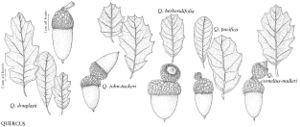Difference between revisions of "Quercus cornelius-mulleri"
Madroño 28: 210. 1981.
FNA>Volume Importer |
imported>Volume Importer |
||
| (5 intermediate revisions by 2 users not shown) | |||
| Line 10: | Line 10: | ||
|special_status={{Treatment/ID/Special_status | |special_status={{Treatment/ID/Special_status | ||
|code=F | |code=F | ||
| − | |label= | + | |label=Illustrated |
}} | }} | ||
|basionyms= | |basionyms= | ||
| Line 38: | Line 38: | ||
-->{{#Taxon: | -->{{#Taxon: | ||
name=Quercus cornelius-mulleri | name=Quercus cornelius-mulleri | ||
| − | |||
|authority=Nixon & K. P. Steele | |authority=Nixon & K. P. Steele | ||
|rank=species | |rank=species | ||
| Line 52: | Line 51: | ||
|publication title=Madroño | |publication title=Madroño | ||
|publication year=1981 | |publication year=1981 | ||
| − | |special status= | + | |special status=Illustrated |
| − | |source xml=https:// | + | |source xml=https://bitbucket.org/aafc-mbb/fna-data-curation/src/2e0870ddd59836b60bcf96646a41e87ea5a5943a/coarse_grained_fna_xml/V3/V3_264.xml |
|genus=Quercus | |genus=Quercus | ||
|section=Quercus sect. Quercus | |section=Quercus sect. Quercus | ||
Latest revision as of 21:47, 5 November 2020
Shrubs, evergreen or subevergreen, densely branched, 1-2(-3) m. Bark gray, scaly. Twigs gray, yellowish, or brownish, 1-1.5 mm diam., densely tomentulose, rarely glabrate. Buds dull brown, ovoid, 2.5-3 mm, glabrous except for margins of scales. Leaves: petiole 2-5 mm. Leaf blade strongly bicolored, ovate to oblong or narrowly obovate, 15-35 ×10-20 mm, rather thick and leathery, base cuneate or attenuate-rounded, margins entire or irregularly, shallowly toothed, teeth mucronate, rarely spinose, secondary veins 6-7 on each side, apex rounded or acute; surfaces abaxially whitish, densely covered with minute, compact, appressed, (8-)10-14(-16)-rayed stellate hairs less than 0.2 mm diam. (lateral fusion of rays visible under high magnification), without glandular seriate hairs, adaxially dull, light green, grayish, or yellowish green, with scattered, appressed-stellate hairs to 0.2 mm diam. Acorns solitary or clustered, subsessile; cup deeply cup-shaped or turbinate, to 5-13 mm deep × 12-20 mm wide, scales whitish or cream, strongly tuberculate especially near base of cup; nut dark brown, fusiform or cylyndric, 20-30 × 10-30 mm. Cotyledons distinct.
Phenology: Flowering early spring.
Habitat: Open chaparral, pinyon and juniper woodlands, desert margins, often on loose granitic soils
Elevation: 1000-1800 m
Distribution

Calif., Mexico (Baja California).
Discussion
Quercus cornelius-mulleri is easily distinguished from other California scrub oaks by the strongly bicolored leaves, dense minute tomentum of the abaxial leaf surface, and large acute acorns in deep tuberculate cups. Of greater difficulty are swarms of putative hybrids with Q. engelmannii, sometimes referred to as Q. ×acutidens.
In Joshua Tree National Monument a lone tree and several shrubs appear to be hybrids and backcrosses between Quercus cornelius-mulleri and Q. lobata. This tree is the basis of Quercus ×munzii J. M. Tucker.
Selected References
None.
